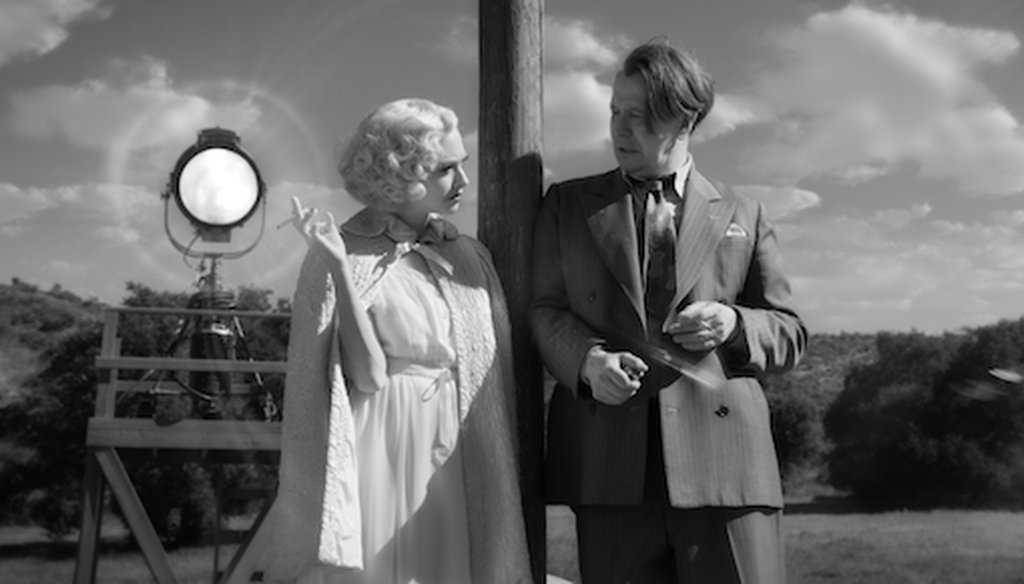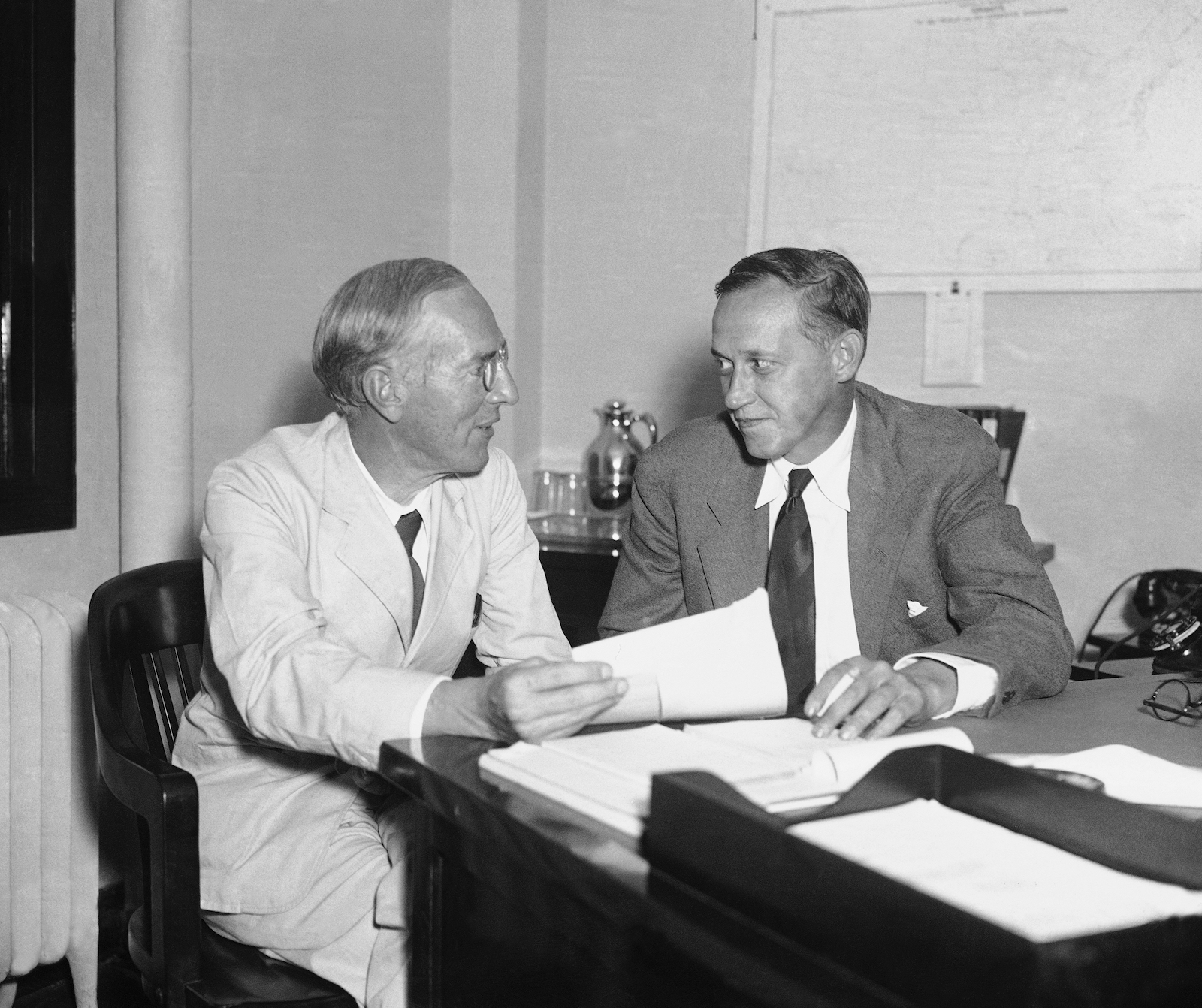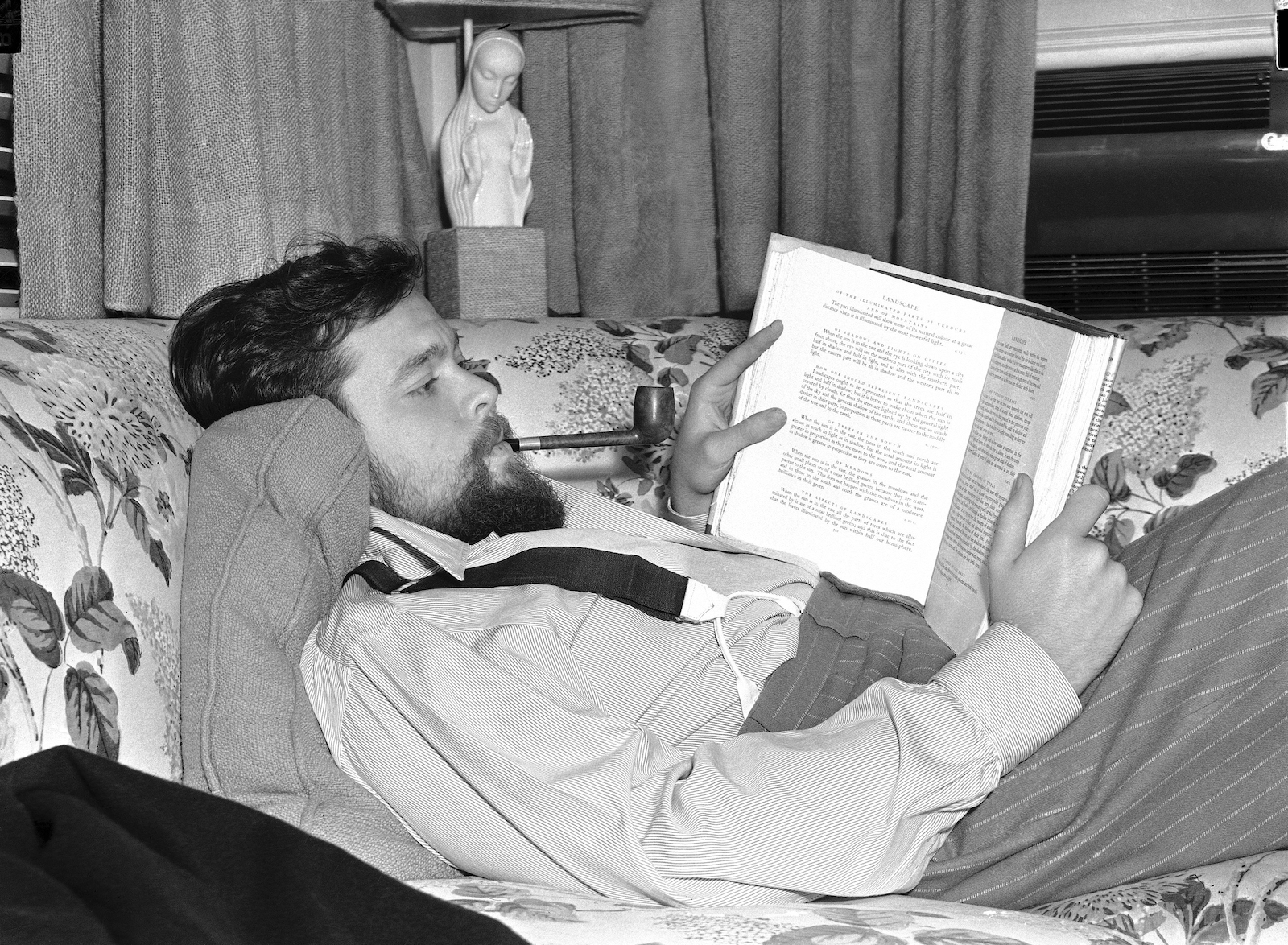Stand up for the facts!
Our only agenda is to publish the truth so you can be an informed participant in democracy.
We need your help.
I would like to contribute

Amanda Seyfried as Marion Davies and Gary Oldman as Herman Mankiewicz. (Netflix)
Editor's note: Have you ever wondered if the movie you just saw — that claimed to be based on a real story or historical events — was really accurate? So have we. With this year’s Oscars featuring historically based movies up for Best Picture honors, we wanted to help you sort out the facts from the dramatic liberties. (We've also fact-checked "Judas and the Black Messiah" and "The Trial of the Chicago 7.") Warning, major spoilers and plot points ahead!
In keeping with the Oscar tradition of honoring movies about movie making, the most nominated film of the year centers on a Hollywood screenwriter.
"Mank" tells the story of Herman "Mank" Mankiewicz, a theater critic, wit and playwright best remembered for co-writing the classic film "Citizen Kane." It’s also a movie about the 1934 California gubernatorial campaign of socialist author Upton Sinclair, which, according to the movie, inspired Mankiewicz to pen his masterpiece.
The film received 10 Oscar nominations, including for best picture, for David Fincher as best director and for Gary Oldman as best actor.
"Mank" is a movie for film nerds, replete with homages to "Citizen Kane," which many consider to be one of the greatest American films of all time. If you haven’t seen it, "Citizen Kane" tells the story of publishing mogul Charles Foster Kane, a fictionalized version of William Randolph Hearst. Hearst built America’s largest newspaper chain through sensational and aggressive coverage of the political issues of his day, and was near the height of his power in 1934.
Sign up for PolitiFact texts
"Mank" asks the question why Mankiewicz wrote a film so critical of Hearst, his former friend, finding its answer in the role Hearst played in squashing Sinclair’s campaign for governor.
To fact-check the film, we spoke with historians and film scholars. At some points, "Mank" hews close to real-world events. At others, it swerves away from the factual record, particularly in the way it attempts to interweave the creation of "Citizen Kane" and the Upton Sinclair campaign.
Finally, the film has a harsh depiction of "Citizen Kane" director Orson Welles, suggesting Welles took a screenwriting credit for "Citizen Kane" that he didn’t deserve. We found the factual record doesn’t support that.
In the movie: William Randolph Hearst funds fake newsreels smearing Upton Sinclair.
In reality: Hollywood studios did create fake newsreels about Sinclair, but there’s no evidence Hearst (or Mankiewicz) was involved.
A good chunk of "Mank" revolves around socialist muckraker and author Upton Sinclair (played, surprisingly, by Bill Nye "the Science Guy") and his campaign for the California governorship.
At the time of his run, Sinclair was famous for several popular novels, including "The Jungle," which condemned the meatpacking industry and inspired national health reforms. Like Sinclair’s novels, his campaign centered on populist rhetoric and an uncompromising socialist message. To announce his plans and platform, Sinclair released a small book that set the tone for his campaign: "I, Governor of California, and How I Ended Poverty: A True Story of the Future."

Socialist author Upton Sinclair (left) during his run for California governor. (AP Images)
The message took off. A mass movement gathered around Sinclair, and the candidate captured the Democratic primary in a landslide. Terrified of a Sinclair governorship, business executives, publishers and Hollywood moguls combined forces to crush him in the general election.
"Sinclair started as a favorite," said Greg Mitchell, author of "The Campaign of the Century," the definitive book on Sinclair’s run. "For a few weeks, everybody, including moderate Democrats, were lining up behind him. Then this incredible campaign against him assembled."
Hollywood executives docked a day’s pay from their employees to donate to Sinclair’s Republican opponent Frank Merriam. Studio heads threatened to move their headquarters to Florida. News outlets like the Los Angeles Times refused to cover Sinclair’s rallies.
Perhaps the most consequential element of the campaign against Sinclair was a series of fake newsreels created by Hollywood film producer Irving Thalberg. These videos, which are faithfully recreated in "Mank," feature "reporters" speaking to "people on the street," many of whom were actually small-time Hollywood actors reciting scripted remarks. Well-dressed individuals criticized Sinclair and praised his opponent. Others, with shabby outfits and heavy accents, asserted that Sinclair was the candidate of the people.
The fake newsreels had "a tremendous effect," said Mitchell, who unearthed the videos in an MGM archive while researching his book. "Sinclair was sailing to victory, but then the newsreels delivered the death blow."
In the film, Hearst’s role funding the videos drives a wedge between him and Mankiewicz, eventually leading the latter to write "Citizen Kane." While Hearst’s newspapers did slander Sinclair in stories and political cartoons, there’s no evidence that the publisher helped fund Thalberg’s newsreels.
It’s true that Mankiewicz and Hearst were friends in real life before growing distant. Mank and his wife attended several dinners and parties at the publisher’s lavish mansion in San Simeon (some of which really did feature giraffes and monkeys). However, biographers have cited Mankiewicz’s excessive drinking and habit of insulting the people around him as reasons for their falling-out, rather than any political stand on the screenwriter’s part.
In the movie: Mankiewicz writes "Citizen Kane" to attack Hearst for his role in defeating Sinclair.
In reality: There’s no evidence Mankiewicz supported Sinclair.
"Mank" casts its subject as a would-be Sinclair supporter horrified at the way the film industry marshals its resources to tip the scales away from a worthy candidate. However, Mitchell told us, "there’s no evidence that Herman Mankiewicz had much interest in the Sinclair campaign at all."
According to Sydney Ladensohn Stern’s biography "The Brothers Mankiewicz," Mank’s personal politics were all over the map: He detested the Nazis, writing an anti-fascist film with a villain named "Adolf Mitler" before much of Hollywood took an openly critical stance toward Germany. In addition, Mankiewicz sponsored hundreds of German refugees as they fled to America, a fact that "Mank" makes much of. But the screenwriter was also an avowed isolationist who identified with Charles Lindbergh, the anti-war aviator who argued against American intervention in Europe and accused American Jews of "agitating for war."
There’s little indication that Mankiewicz had sympathy for the brand of socialism that Sinclair represented. Mankiewicz was a fierce opponent of the burgeoning Screen Writers Guild, which marked Hollywood’s first step toward left-of-center politics. According to Mitchell, Hollywood was "famously conservative" until Franklin Delano Roosevelt’s election and the notorious actions of the moguls during the Sinclair campaign generated a surge of support for unionization. Mankiewicz publicly resisted this leftward turn, taking out a full-page advertisement in Variety that viciously mocked the guilds. (A scene in "Mank," which features Mankiewicz criticizing the unions, quotes some of the lines from the ad.)
Faced with Mankiewicz’s contradictory political stances, "Mank" seeks to put a personal spin on his disillusionment with Hearst through a fabricated subplot. In the movie, one of Mankiewicz’s friends, a test shot director named Shelly Metcalf, films the newsreels for Thalberg. After Sinclair blames the newsreels for his defeat, Metcalf, who is suffering from Parkinson’s disease, becomes overwhelmed with regret and commits suicide.
Shelly Metcalf didn’t exist. The man who actually filmed the fake newsreels was a director named Felix Feist Jr. Feist’s politics were conservative, and he continued to make movies and television episodes through the 1950s.
In the movie: Mankiewicz writes "Citizen Kane" on his own.
In reality: Welles played a pivotal role in shaping and writing the final script.
The authorship of the "Citizen Kane" script has been debated almost from the moment the movie was released, with Mankiewicz and Welles each asserting that he deserved primary credit. Mank, who did not attend the Oscars the year "Citizen Kane" won the award for Best Original Screenplay, reportedly told Welles that his acceptance speech would have been: "I am very happy to accept this award in Mr. Welles' absence because the script was written in Mr. Welles' absence."

Orson Welles, the director of Citizen Kane, in 1939. (AP Images)
New Yorker film critic Pauline Kael fueled the controversy with a long 1971 essay called "Raising Kane" in which she alleged that Welles had played virtually no role in the writing of his masterpiece "Citizen Kane." The essay immediately caused an uproar, and Welles’ friend and fellow director Peter Bogdanovich penned a furious riposte to Kael in Esquire. Kael’s critics pointed out that she had neglected to interview people who disagreed with her (including Welles) and that she had ignored substantial documentary evidence that contradicted her claims.
Nowadays, film experts consider her essay to be "completely discredited and terribly flawed," said Harlan Lebo, a cultural historian who has written two books on "Citizen Kane." "There’s very little in there that’s factually accurate. (Kael) based her writing on her own judgement and not on any easily available facts."
Nevertheless, Jack Fincher, the "Mank" screenwriter, drew inspiration from Kael’s essay. While "Mank" does include a scene of Welles announcing his intentions to rewrite the script, the film generally echoes Kael’s position that "Citizen Kane" emerged from Mankiewicz’s own personal relationship to Hearst and that the screenwriter should be credited as the genius behind the film.
The record, though, shows that Welles played a pivotal role writing the script and adapting it to film. In a detailed and well-regarded analysis of the different drafts of the "Kane" script, film scholar Robert Carringer arrived at the conclusion that Mankiewicz wrote the first draft, but that Welles’ contribution was "not only substantial but definitive."
The film also downplays the role that Welles’ friend and artistic collaborator John Houseman played in the writing process. In the film, Houseman checks in on Mankiewicz every so often while Mank is convalescing from a car crash at a ranch in Victorville, Calif., then drives off to a separate hotel. In reality, Houseman slept in another room in the ranch and frequently reviewed and offered comments on the "Kane" script while Mank was writing.
Mankiewicz’s Victorville draft was essentially a thinly-veiled biopic of Hearst, with specific scenes taken directly from the mogul’s life. Karringer writes that this draft was "a solid durable story structure" that Welles used as "a source work at the service of an original independent creation."
After the script was handed over to Welles, Carringer writes, the director took what he liked and discarded the rest over the course of two months, transforming it "from a solid basis for a story into an authentic plan for a masterpiece."
In addition, said Lebo, "Mank" doesn’t account for the fact that many scenes in "Citizen Kane" don’t actually appear in the final script. Some crucial parts in the finished movie appear to have been conceptualized and written by Welles during the production and filming of "Citizen Kane" itself.
"There’s no record anywhere of those scenes in any of the scripts," Lebo said. "It drives me crazy thinking about that."
Our Sources
Between Rock and a Hard Place, "Mank," for the memories, Apr. 7, 2021
Vox, The tangled history behind David Fincher’s Mank — and its link to Citizen Kane — explained, Dec. 4, 2020
Sydney Ladensohn Stern, "The Brothers Mankiewicz," published 2019
Greg Mitchell, The Campaign of the Century, published 1991
Slate, What’s fact and what’s fiction in Mank, Nov. 18, 2020
Newsweek, 'Mank' on Netflix: Did Herman Mankiewicz bring 100 refugees to the US? Dec. 4, 2020
Time, Praising Kane, Jan. 29, 1996
New Yorker, Raising Kane, Feb. 12, 1971
Esquire, The Kane Mutiny, Oct. 1, 1972
Criterion, The man in the wings: David Fincher on the shadowy life of Herman Mankiewicz, Jan. 14, 2021
Critical Inquiry, The scripts of Citizen Kane, 1978
Interview with Greg Mitchell, Apr. 9, 2021
Interview with Harlan Lebo, Apr. 12, 2021
Email interview with Robert Carringer, Apr. 12, 2021






























